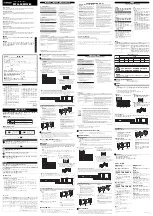
12
£
WARNING: The minimum pilot test must be accomplished by a trained and qualified burner
technician.
Minimum Pilot Test
This test insures that the flame detector will not sense a pilot flame too small to light the main flame
reliably. It must be made on every new installation as well as following the repositioning of the flame
detector.
This procedure should not be used on a direct spark ignited burner.
1.
Manually shut off the fuel to the main burner.
2.
Connect a test meter to the test jacks on the Amplifier Module.
3.
Initiate a normal startup.
4.
Reduce the fuel to the pilot until the DC voltmeter reads 3.5 volts for UV scanners. See WARN-
ING below. This is the minimum pilot. For flame rectification the flame signal for minimum
pilot varies depending on the application. See WARNING below.
5.
Slowly turn on the main fuel and insure that the main flame lights off promptly and normally.
WARNING: If light off is delayed, shut off the power to the installation. Realign the flame
detector so that pilot flame detection requires a larger pilot flame. Repeat this test until the
main flame lights reliably with minimum pilot.
6.
After the minimum pilot test is completed satisfactorily, increase the pilot flame to normal size,
and observe that the main flame is properly established during a normal cycle.
Flame Failure Test
1.
Temporarily connect spark ignition and pilot valve to Terminal #3.
2.
Initiate a normal startup.
3.
Manually shut off all fuel and observe the loss of flame signal on the test meter.
4.
If flame signal does not reduce to zero within the flame failure response time of the control
(F.F.R.T. determined by selection of amplifier), verify that the UV flame detector is not actuated
by the spark. If spark is detected, a metallic shield or relocation of the UV detector sight pipe is
required.
5.
IMPORTANT:
When the test is completed, reconnect the spark ignition to Terminal #4.
Recommendation
Periodic Safety Check:
Test the complete flame safeguard system at least once a month. This test
should verify flame failure safety shutdown and positive fuel cutoff when the fuel valve is de-ener-
gized.
Replaceable Fuse
The programmer modules are designed with a field replaceable fuse. The fuse is located on the
printed circuit board near the connectors. In the event the fuse becomes shorted, the Operating Con-
trol, Air Flow, and PTFI LED’s will light. However, KL or KF (see WIRING ARRANGEMENTS -
later in this document) will not be energized and the control will lock out. The fuse will blow as a
result of an overload condition on Terminals 3, 4, or 5. To replace the fuse, remove the fuse (using a
small screwdriver) and install a Fireye replacement fuse (P/N 23-176) or equivalent 2AG, 8 amp fuse
Type Fast-Acting (e.g. Little Fuse #225008).
Order Fireye replacement fuse P/N 23-183 or equivalent (3.5 amp fuse 2AG Type SLO-BLO) for
programmer modules used with the MC230 and MC230R chassis (e.g. Little Fuse #22903.5).




































